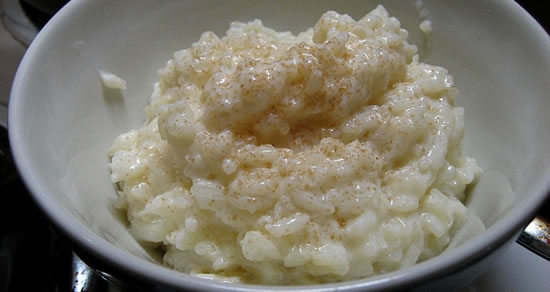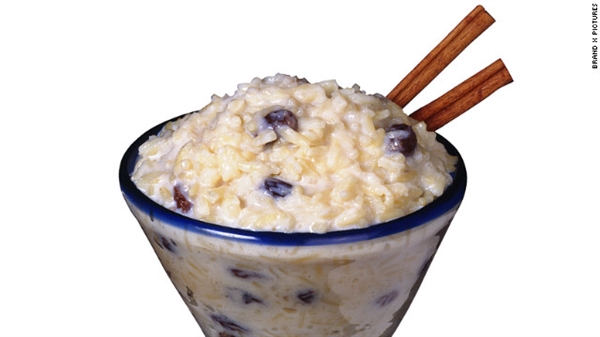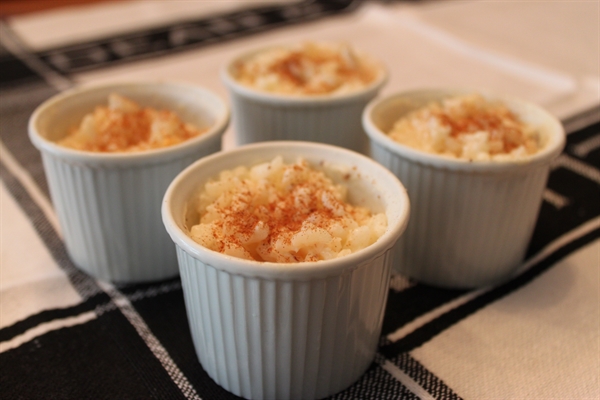Rice Pudding Day 2024 is on Friday, August 9, 2024: rice pudding recipe?
Friday, August 9, 2024 is Rice Pudding Day 2024. Rice Pudding - Create Delicious Pudding Dishes Try Uncle Ben's® Rice Recipes!

Nothing tastes quite just like a homemade grain pudding out of your favourite grain pudding recipe. Rice Pudding Day challenges you not just to enjoy more adventurous grain pudding quality recipes, from rum’n'raisin to more unusual elements like lychees and nuts.

Easy Rice Pudding Recipe:
2 c. cooked rice
1/2 c. sugar
2 eggs, slightly beaten
2 c. milk
1/2 tsp. vanilla
1/4 c. raisins
1/2 tsp. powdered cinnamon
PREPARATION:
Place rice in bowl, add all ingredients, stir to mix. Pour into greased baking dish or pan. Bake about 25 minutes in a 350 degree oven.
Creamy Rice Pudding
INGREDIENTS:
1 quart milk, scalded
1/4 cup long grain rice
1/4 cup granulated sugar
1/2 teaspoon vanilla
PREPARATION:
Preheat oven to 300°. In a 1 1/2 quart baking dish, combine all ingredients. Bake for 2 1/2 hours, stirring every 20 minutes. This will give the pudding a creamy texture.
Custard Rice Pudding:
INGREDIENTS:
1/2 cup plain cooked rice
3 eggs, beaten
1/2 cup sugar
1/4 teaspoon salt
1 teaspoon vanilla extract
1 teaspoon grated lemon rind
1/2 cup raisins
3 1/2 cups milk
ground nutmeg, freshly ground if possible
PREPARATION:
In a large mixing bowl, mix all ingredients except nutmeg. Pour mixture into a lightly buttered shallow baking dish and sprinkle with nutmeg. Place baking dish in a pan of hot water in oven and bake at 300° for about 1 1/2 hours, or until set. A clean knife inserted into the center should come out with nothing clinging to it. Serve warm or chilled with whipped cream or whipped topping, if desired.

what is a great recipe for rice pudding?
A recipe for rice pudding is found in the (1615) domestic guide, Gervase Markham, The English Huswife:
Take a half pound of rice and steep it in new milk a whole night and in the morning drain it and let the milk drop away; then take the best, sweetest and thickest creme and put the rice into it and boil it a little; and set it to cool an hour or two and after, put in the yolks of half a dozen eggs, a little pepper, cloves, mace, currants, dates, sugar and salt; and having mixed them well together, put in a great store of beef suet well beaten and small shred and so put it into the frames and boil them as before showed, and serve them after a day old.
The 1881 Household Cyclopedia also has a recipe for plain rice pudding:
One quart of milk
1/2 teacup of rice
2 teaspoons of sugar
1/2 of a nutmeg grated
a small piece of butter, size of hickory-nut.
Pick and wash the rice; add all the ingredients. Stir all well together, and put in a slack oven one and half to two hours. When done pour it in a pudding dish, and serve when cold. If baked in an oven, take off the brown skin before it is poured in the pudding-dish, and replace it on the Sop of the pudding as before.
One typical modern recipe for rice pudding is:
4 cups milk
1/2 teaspoon salt
1/4 cup uncooked rice
2/3 cup sugar
Optional: 1/2 teaspoon cinnamon or nutmeg; 1/2 cup raisins, chopped dates, or chopped figs
Mix ingredients and bake uncovered 3 hours at 300° F, stirring several times during the first hour.

what is the history of rose pudding?
Rice pudding around the world
Middle East
"Firni, a sweet milky dessert, to be eaten cold, made either with cornflour or rice flour or sometimes both and usually flavoured with rosewater and/or ground cardamom. The dish is decorated with chopped or ground almonds or pistachio nuts...the history of firni goes back a very long way; it seems to have originated in ancient Persia or the Middle East; and to have been introduced to India by the Moghuls."
---Oxford Companion to Food, Alan Davidson [Oxford University Press:Oxford] 1999 (p. 300)
"Shola...the name given to a number of dishes all over the Middle East, Iran, and Afghanistan in which short-grain rice is cooked until soft and thick, wtih other ingredients chose according to whether the shola is be be savoury or sweet...sholleh was brought to Perisa by the Mongolians in the 13th century...Shola-e-zard is a sweet saffron and rosewater (or orange flower water) flavoured rice dish...It has a religious significance, being made on the 10th day or Muharram (the Muslim month of mourning)...also made as a nazr, which is a custom of thanksgiving or pledge practiced in Iran and Afghanistan. The shola is cooked and then distributed to the poor and to neighbours and relatives."
---Oxford Companion to Food, Alan Davidson [Oxford University Press:Oxford] 1999 (p. 720)
Asia
"Kheer is the Indian name for sweet milk puddings usually made with rice, although it can also be made with fine noodles called seviyan, or semolina, carrots or sage. It is sometimes called sheer, which means milk in Persian. It probably originated in Persia where a similar dessert is known as sheer birinj (rice pudding). There are many variations in the flavourings which can include raisins, cardamom, cinnamon, almond, pistachio, saffron, kewra essence...or rosewater, etc. For special occasions it is customary to decorate the chilled kheer with edible silver or gold leaf. The Persian version, sheer birinj, according to Kekmat...was originally the food of angels, first made in heaven when the Prophet Muhammad ascended to the 7th floor of Heaven to meet God and he was served this dish."
---Oxford Companion to Food, Alan Davidson [Oxford University Press:Oxford] 1999 (p. 431)
"Kheer. A sweet confection based on rice. When prepared as a ritual pucca' food, the rice is first lightly fried in ghee before boiling with sugared milk till the milk thickens. A kheer of jowar is mentioned in the fourteenth century padmavat of Gugarat, and other cereal products (vermicelli, cev, pheni) may be used as well. A thinner product is payasam, and both are popular desserts, routinely as well as on festive occasions. The Hindi word kheer derives from the Sanskrit ksheer for milk and kshirika for any dish prepared with milk."
---A Historical Dictionary of Indian Food, K. T. Achaya [Oxford University Press:Delhi] 1998 (p. 130)
"The Chinese eight jewel rice pudding is so named because it is made with eight different kinds of fruit preserved with honey. Eight was said by Confucius to be the number of perfection. The fruits are arranged on the bottom of the dish and cooked, sweetened glutinous rice poured on top. The pudding is then steamed for several hours so that the rice breaks down into a homogenous mass."
---Oxford Companion to Food, Alan Davidson [Oxford University Press:Oxford] 1999 (p. 665)
Europe
"Rice pudding is the descendant of earlier rice pottages, which date back to the time of the Romans, who however used such a dish only as a medicine to settle upset stomaches. There were medieval rice pottages made of rice boiled until soft, then mixed with almond milk or cow's milk, or both, sweetened, and sometimes coloured. Rice was an expensive import, and these were luxury Lenten dishes for the rich. Recipes for baked rice puddings began to appear in the early 17th century. Often they were rather complicated...Nutmeg survives in modern recipes. It is now unusual to add eggs or fat, and rice pudding has tended to become a severely plain nursery dish. Nevertheless, it has its devotees."
---Oxford Companion to Food, Alan Davidson [Oxford University Press:Oxford] 1999 (p. 665)
"Northern Italians fancy themselves as having a monopoly on the consumption of rice, but in fact rice first entered Europe as a foodstuff via Arab-occupied Spain and Sicily. The Romans knew rice only as an extremely expensive commodity imported in small quantities from India for medicinal purposes."
--- Pomp and Sustenance: Twenty-Five Centuries of Sicilian Food, Mary Taylor Simeti [ECCO Press:Hopewell NJ] 1998 (p. 69)
RECIPES
Recipe for early Roman rice pudding:
"Oriza
Rice is boiled in fresh water. When it is properly cooked, the water is drained off and goat's milk is added. The pot is put on the flame and cooked slowly until it becomes a solid mass. It is eaten like this hot, not cold, but without any salt or oil--Anthimus On the Observance of Food








